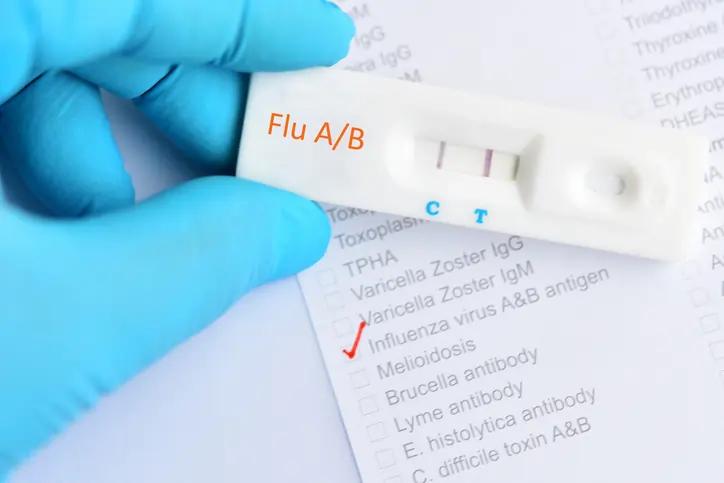Influenza Diagnostic Market to Reach USD 3.34 Billion by 2034 | Fact.MR Report
Influenza Diagnostic Market to Reach USD 3.34 Billion by 2034 | Fact.MR Report
Published by Jessica Weisman-Pitts
Posted on March 10, 2025
Published by Jessica Weisman-Pitts
Posted on March 10, 2025
The global influenza diagnostic market is projected to be valued at US$ 1,806.5 million in 2024, with expectations to reach US$ 3,336.9 million by 2034, growing at a CAGR of 6.3% from 2024 to 2034. The increasing focus on early detection for effective influenza management is a key driver of market expansion.
In the post-pandemic era, heightened awareness of health and personal care has significantly boosted the demand for influenza diagnostic solutions, particularly in regions with well-developed medical infrastructure. Additionally, the flourishing pharmaceutical industry plays a crucial role in fueling market growth.
The rising incidence of influenza is another major contributor to market expansion. The emergence of new and evolving viral strains underscores the need for advanced diagnostic tools that facilitate outbreak tracking and strain identification, enabling timely and targeted interventions.
Furthermore, technological advancements in diagnostic methods are shaping the market's trajectory. Innovations in molecular diagnostics, rapid antigen tests, and other testing techniques have significantly enhanced the accuracy and efficiency of influenza detection. These advancements are encouraging broader adoption among healthcare providers and institutions, further propelling market growth.
In 2019, the influenza diagnostic market generated an estimated revenue of US$ 1,356.9 million. From 2019 to 2023, the market expanded at a CAGR of 5.89%, adding US$ 449.6 million in revenue.
For More Insights into the Market, Request a Sample of this Report: https://www.factmr.com/connectus/sample?flag=S&rep_id=6682
Country-wise Insights on the Influenza Diagnostic Market
North America: A Market Poised for Strong Growth
The North American influenza diagnostic market is set for significant expansion, with a projected CAGR of 6.40% through 2034. The rising demand for influenza diagnostics across key countries, particularly the United States and Mexico, is fueling this growth. The United States dominates the regional market, holding an estimated 87.70% share in 2024.
East Asia: A Rapidly Growing Market
The East Asian influenza diagnostic market is also expected to witness considerable progress, with a CAGR of 6.60% in 2024. Among the countries in this region, Japan leads the market, commanding a 45.10% share in 2024.
The United States remains the undisputed leader in the North American influenza diagnostic market, thanks to several key factors:
Advanced Healthcare Ecosystem: The country boasts state-of-the-art medical facilities, laboratories, and diagnostic centers, ensuring rapid adoption of innovative influenza diagnostic technologies.
Strong R&D Initiatives: The United States is a global hub for biotechnology, pharmaceuticals, and medical research, driving the continuous development of cutting-edge diagnostic solutions.
Government and Private Sector Investments: Increased funding in healthcare infrastructure and disease surveillance has further strengthened the market's expansion.
With these factors in place, the United States is expected to maintain its dominance in the influenza diagnostic market, setting the pace for global advancements in the field.
Key Companies Profiled:
Category-wise Insights:
In terms of test type, traditional diagnostic tests are expected to dominate the market, holding a 66.70% share in 2024, while molecular diagnostic tests will account for 33.30%. The latter segment plays a crucial role in enhancing the market’s resource diversity and stability, offering advanced detection methods for improved accuracy.
By end user, the hospital segment leads the influenza diagnostic industry, securing a 54.40% market share in 2024. Hospitals and clinical laboratories remain the primary users of influenza diagnostic solutions, driven by the growing need for rapid and precise identification of influenza cases in patients with respiratory symptoms. Their increasing adoption is instrumental in enabling timely and appropriate treatment strategies, effectively reducing the severity of illness.
Moreover, early and accurate diagnostic solutions play a vital role in preventive healthcare, helping mitigate the risk of hospital-acquired infections among both patients and healthcare workers.
Competitive Landscape of the Influenza Diagnostics Market
The influenza diagnostics industry is composed of a diverse range of players operating at multiple levels. These include global industry leaders, mid-sized enterprises, and smaller companies with niche offerings.
Recent Developments:
November 2023: Mylab and Ekincare partnered to promote NASOVAC-S4, a nasal influenza vaccine. Delivered non-invasively and painlessly, it is an appealing choice for corporate employee wellness programs.
November 2023: Researchers at the Gwangju Institute of Science and Technology developed metal-enhanced fluorescence probes for detecting the influenza A virus. Integrated into a lateral flow immunosensor, this innovation enables rapid, accurate, cost-effective, and highly sensitive molecular diagnostics, identifying the virus in under 20 minutes.
January 2023: Roche secured European Commission approval for Xofluza, an influenza treatment and prevention drug for children aged one year and older. As the first antiviral with a novel mechanism of action in nearly two decades, it halts viral replication faster than oseltamivir.
Get Customization on this Report for Specific Research Solutions: https://www.factmr.com/connectus/sample?flag=S&rep_id=6682
Key Segments Covered in Influenza Diagnostic Industry Research:
The influenza diagnostic industry research categorizes key segments based on test type, end user, and region. In terms of test types, diagnostics are divided into traditional and molecular methods. Traditional influenza diagnostic tests include rapid influenza diagnostic tests (RIDTs), direct fluorescent antibody (DFA) tests, viral culture, and serological assays. Molecular influenza diagnostic tests incorporate advanced techniques such as reverse transcription polymerase chain reaction (RT-PCR), isothermal nucleic acid amplification tests (INAAT), loop-mediated isothermal-based amplification assays, and transcription-mediated isothermal-based amplification assays.
The market is further segmented by end users, including hospitals and clinical laboratories, diagnostic reference laboratories, and academic/research institutes, which are instrumental in influenza detection and research. From a regional perspective, the industry spans North America, Latin America, Europe, Asia Pacific, and the Middle East & Africa (MEA), each with distinct market dynamics and growth opportunities.
Check out More Related Studies Published by Fact.MR Research:
Global Diagnostic Catheters Market to Reach $6 Billion by 2031 with 6% CAGR
Diagnostic Imaging Centers Market to Hit $179 Billion by 2035, Growing at 5.9% CAGR
Diagnostic Imaging Services Market to Reach $1 Billion by 2032, Growing at 5.51% CAGR
Blood Cancer Diagnostics Market to Reach $28.57 Billion by 2032, Growing at 6% CAGR
Breast Cancer Diagnostics Market to Reach $12.45 Billion by 2035, Growing at 6.9% CAGR

Explore more articles in the Research Reports category











